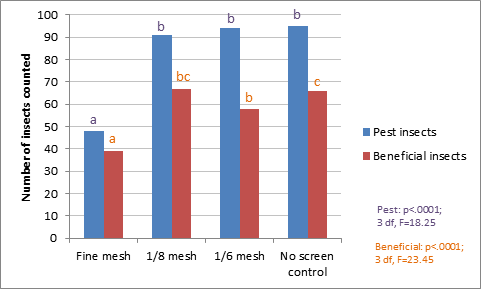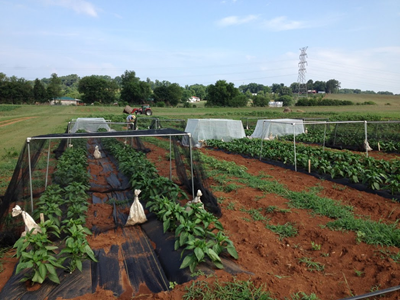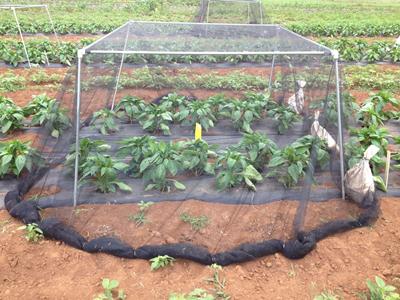(Rogers, Moore and Wszelaki)
The brown marmorated stink bug (BMSB) is an exotic pest from Asia, first discovered in the U.S. in Pennsylvania in the late 1990s. Currently, BMSB has been found in 42 states and two Canadian provinces. BMSB was first confirmed in Tennessee in 2008 (Knox County). Populations are expected to continue to increase and spread throughout the country. In addition to feeding on a variety of crops, BMSB is also a nuisance pest when it invades homes and human-made structures to overwinter. It is considered one of the most devastating pests of agriculture in the mid-Atlantic region in the past 50 years.
Brown marmorated stink bugs (Halyomorpha halys (Stål), order Hemiptera, family Pentatomidae) have a characteristic shield-shape and adults are approximately 1.7 cm long and just as wide. They have a mottled brown coloration, and can be distinguished from native stink bugs by white bands on the antennae, and alternating light and dark bands at the rear of the front pair of wings. When disturbed, they emit a pungent odor, similar to the scent of cilantro. Eggs are laid in clusters and are blue-green when newly laid, changing to white as they near hatching. Newly hatched nymphs are black and reddish-orange colored, resembling ticks. Later stage nymphs are black and white with white banding on legs and antennae. BMSB is often confused with native stink bugs such as the southern green stink bug and the brown stink bug . Another way to distinguish BMSB from native brown stink bugs is the brown–gray underside; native brown stink bugs have a yellowish-green underside (see pictures here). For pictures and more identification info see the Stop BMSB website.
Stink bugs are generalists and feed on over 170 different species of plants. This includes a variety of fruits and vegetables such as apples, peaches, figs, citrus, berries, grapes, soybean, tomatoes, peppers, okra, beans, squash and corn. Stop BMSM has a more complete of host plants. All stink bugs have piercing-sucking mouthparts. Their feeding results in distortion, puncture wounds and cat-facing, leaving the product unmarketable. Visit Crop-by-crop at Stop BMSB website for damage photos.
Brown marmorated stink bugs are very difficult to control. Conventional control for BMSB involves multiple pesticide applications. Research has shown that some of these sprays only cause a “knock-down” of BMSB with many adults recovering from a moribund state up to seven days after being sprayed (Leskey et al. 2012a). Other studies have found that pesticides causing 100% mortality in the lab only resulted in 60% mortality early in the summer, declining to 40-20% by the end of summer (Leskey et al. 2014). In the mid-Atlantic region in 2011, some growers targeted BMSB with 4 times higher pesticide applications, which killed many natural enemies leading to outbreaks of secondary pests (Leskey et al. 2012b). Even if control is achieved, BMSB adults can migrate and repopulate. Current research is helping to identify management strategies for organic growers, including trap cropping, identifying natural enemies, and protection with barrier fabrics. Barrier fabrics can be used to protect high value crops from BMSB and native stink bug damage. An experiment testing 3 different mesh sizes of barrier fabric to protect bell peppers was conducted in 2013 and 2014 at the UT Organic Crops Unit in Knoxville.
- Bell peppers ‘Aristotle’ as test crop
- 4 replicates of 4 cage treatments
- 13-15 plants per cage (4 ft tall, 5 ft long, 6 ft wide)
- Treatments:
- Fine mesh (white)
- 1/8” mesh (black)
- 1/6” mesh (black)
- No screen
- Scouted pepper plants weekly for :
- BMSB and native stink bugs
- Natural enemies
- Yellow sticky cards were placed in cages starting 8-July, 2013 and 1-July, 2014 and replaced weekly for six weeks (2013) and seven weeks (2014).
- Plants in cages were scouted during harvests for BMSB and native stink bugs.
- Peppers were harvested in the mature green stage and marketable peppers were graded according to USDA size classes (‘Fancy,’ ‘No. 1,’ and ‘No. 2’). Unmarketable peppers were divided according to damage (stink bug damage or other culls – disease, chewing insects, etc.). There were four harvest dates in 2013 and six dates in 2014.
- Stink bug damage was assessed on fruit and rated for severity by counting the number of feeding sites.
- Harvest data and yellow sticky card data were analyzed in SAS 9.3 (SAS Institute 2011) using a macro developed by Arnold Saxton at the University of Tennessee. A Mixed Model Analysis of Variance (MMANOVA) was performed on the data with year and treatment classified as fixed effects and block and block by year designated as random effects. Due to unequal variance, the percentage of peppers harvested with stink bug damage was arcsine square root transformed and pest and beneficial insects count data were square root transformed. Untransformed means are reported.




- The fine mesh covers resulted in the highest yields of marketable fruit.
- The fine mesh covers were better at excluding all insects than the 1/8” and 1/6” covers.
- The fine mesh covers helped prevent damage due to piercing-sucking insects.
- All size mesh covers had higher yields of fancy and number 1 grade peppers compared to unscreened control plots.
Leskey, T.C., Lee, D.-H., Short, B.D., Wright, S.E., 2012a. Impact of Insecticides on the Invasive Halyomorpha halys; (Hemiptera: Pentatomidae): Analysis of Insecticide Lethality. Journal of Economic Entomology 105, 1726–1735. doi:10.1603/EC12096
Leskey, T.C., Short, B.D., Butler, B.R., Wright, S.E., 2012b. Impact of the Invasive Brown Marmorated Stink Bug, Halyomorpha halys (Stål), in Mid-Atlantic Tree Fruit Orchards in the United States: Case Studies of Commercial Management. Psyche: A Journal of Entomology 2012, 1–14. doi:10.1155/2012/535062
Leskey, T.C., Short, B.D., Lee, D.-H., 2014. Efficacy of insecticide residues on adult Halyomorpha halys (Stål) (Hemiptera: Pentatomidae) mortality and injury in apple and peach orchards. Pest Management Science 70, 1097–1104. doi:10.1002/ps.3653
This project was funded in 2012 by the Organic Research and Extension Initiative grant, part of the USDA National Institute of Food and Agriculture. Grant number 2012-51300-20097. For more information on this multi-state project.


